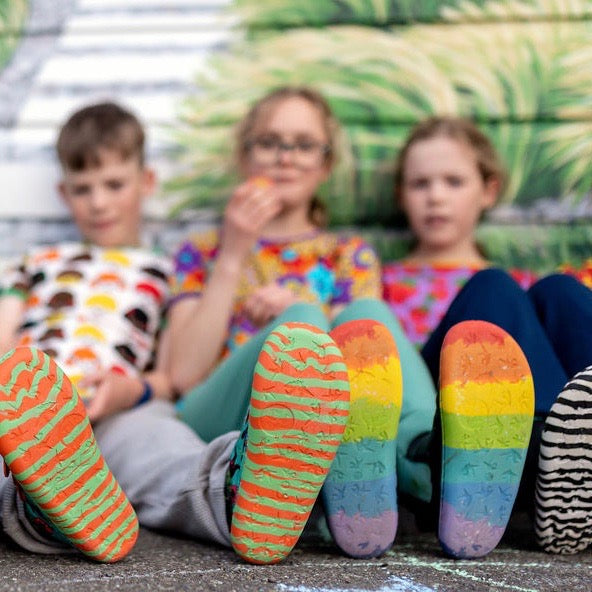
Why Barefoot Shoes, and How to Get Used to Them
Behind the scenes at Hoopla we've been experimenting for a long time with different barefoot shoe brands on our own feet.
It's been a fun exploration and we're stoked to have found fun, thoughtfully designed, affordable barefoot and minimal shoe brands suitable for everyone.
We get a real kick out of PaperKrane's super fun, bright, well-considered barefoot shoes. They are brilliant for everyday wear, and are unique to anything we've seen before. PaperKrane shoes are designed locally in Australia, and made in close partnership with their manufacturing team in Vietnam. Hoopla Kids Chief, Kirsten, says 'These shoes are just right up my alley. I think they are the sort of shoes I've looked for since I was younger!'
Plae's range, while not technically 'barefoot', offer sturdy yet very flexible foot shaped shoes for busy young feet, as well as making shoes for water, school and the great outdoors. Their shoes are also made in Vietnam.
Another brand we have a lot of time for is Xero Shoes, particularly their Z-Trail sandals for kids and adults. Xero Shoes are based in the US, with offices now in Australia. They use recycled nylon fibres for their webbing straps, and 2 thin layers of foam set on a rubber grip sole for the Z-Trail range. These sandals are very flexible and thin. with excellent traction for off-road adventures.
You might've seen the term before, but what does it mean for shoes to be considered 'barefoot' or 'minimal'?
The key features are that the shoes are flat, or parallel to the ground (no raised heels here). Also known as 'zero drop'. Barefoot shoes allow your feet to connect to the ground just as nature intended, but protected from the elements. Our feet are full of sensors and nerves that transmit information to the brain, helping us make adjustments to our posture and balance as we move. The barefoot shoe movement points out that our feet are magnificent, biomechanical wonders - a perfect feature we have that connects us to the world.


This means that good barefoot shoes have very thin, flexible soles that protect you from the elements but don't interfere with your foot sensors sending ‘optimal movement information’ to the brain. They generally have no arch support, based on the idea that our feet arches strengthen through active, engaged use. Many barefoot shoes are roomy enough that you could insert prescribed orthotics, if you need to.
Barefoot shoes are also foot shaped, with a wider toe box than regular modern shoes to accommodate the natural splay of your toes as you flex your feet.
With the deliberate thin sole, when wearing barefoot shoes, people find they often need to adjust the way they strike (or land) feet on the ground. Modern thick, chunky footwear cushions a lot of the sensations of walking/running, causing us to hit the ground heel first (a heel strike).
Have you noticed how your gait changes when you're moving in bare feet? If we walk in bare feet with a heavy heel strike, it quickly hurts. When in bare feet, we often naturally shift to using a gentler mid-foot strike or a very gentle toe strike where we land on the balls of our front foot like we're sneaking or walking across hot concrete. This is unconsciously done - the result of sensory messaging between our brain and feet responding to the ground.
Our feet are designed to make all of these varied ground connections, and our footwear can support natural styles of movement, rather than hinder them. This is an important consideration when looking for suitable kids footwear. We're not just looking for cool kicks! But for shoes that let them move as they naturally do. Learning balance, coordination and gaining agility comes from having that clear brain-to-ground connection. Barefoot shoes offer all the ground feedback with enough protection to keep you moving happily.

These features make barefoot shoes feel different to wear than regular shoes, and it can take time and some practice to adjust. Nothing serious - just take it easy for a few wears. Maybe no long walks or runs! Stop if your feet or legs feel weary, and think about your movements as you go about your day. You can even add an extra inner sole to help ease into that unique ground sensation.
As you wear the shoes in, your feet and leg muscles will build up stamina and before you know it you'll have transitioned into moving comfortably in barefoot shoes.

